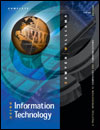 |  Using Information Technology: A Practical Introduction to Computers and Communications, 5/e Brian K. Williams
Stacey Sawyer
INTRODUCTION TO INFORMATION TECHNOLOGY: Mind Tools for Your Future
Web Summary- Infotech Becomes Commonplace. Information_technology
merges computers and high-speed communications; new infotech phones are an
example. Computer—a
programmable, multiuse machine that processes data into information. Communications—electromagnetic
devices and systems for communicating over distances. Online—using
a computer to access information and services via a network.
Infotech has given us some now-commonplace technologies: Email—messages
transmitted over a computer network,
a communications system connecting computers. Major components of cyberspace—the
wired and wireless world of communications—are the Internet,
a network of 400,000 smaller networks, and its graphical subsection, the
World Wide Web,
which stores information in multimedia
form—text, graphics, sound, video. - The "All-Purpose Machine." Computers are of five types.
(1) Supercomputers—perform
1 trillion calculations per second. (2) Mainframes—for
processing millions of calculations; often accessed by a terminal, a display screen and keyboard that can't do its own processing. (3)
Workstations—used
for scientific, mathematical, engineering, and certain manufacturing applications.
(4) Microcomputers—personal computers, which may be desktop PCs, tower PCs, laptops, or personal digital assistants (PDAs);
frequently used to connect to a local area network (LAN),
which links equipment in an office or building. (5) Microcontrollers—tiny
specialized computers installed in cars and appliances. Servers
are central computers holding data and programs for many other computers.
- Understanding Your Computer. You should know three things: (1) The
purpose of a computer is to process data,
raw facts, into information,
summarized data. (2) Hardware
consists of machinery and equipment; software
instructs the hardware what to do. (3) Computers perform four basic operations:
input,
putting data into the system; processing,
manipulation of data into information; storage,
of two types—memory,
which temporarily holds data to be processed, and secondary storage,
which holds data or information permanently; output,
putting out the results of processing. In addition, communication could be
considered a fifth operation.
Input hardware includes the keyboard,
which converts characters into signals readable by the processor, and
the mouse,
used to manipulate objects on the display screen. Processing and memory hardware includes the case (system cabinet),
which contains: a processor chip
with miniature electronic circuits that process information in megahertz,
millions of processing cycles per second; and memory chips (RAM Chips),
which hold data prior to processing. Both chips are connected to the
motherboard,
which contains expansion slots
for plugging in additional circuit boards. Storage hardware includes: a floppy-disk drive,
which stores data on removable 31⁄2-inch disks; a hard-disk drive,
which stores data on a nonremovable disk platter; and a CD-ROM drive,
which reads data from optical disks. Output hardware includes: a video card
, which converts processor information so it can be displayed as text
and images on the monitor;
a sound card,
which outputs sound to speakers;
and a printer,
which produces images and text on paper. Communications hardware includes a modem,
which sends and receives data over phone lines to and from computers. Software is of two types. System software
helps the computer perform essential operating tasks. Application software
performs specific tasks, such as word processing. - Where is Infotech Headed? Computer developments have focused on three
areas: miniaturization, speed, and affordability. Three developments in communications
may be noted: connectivity,
the ability to connect with computers via communications lines; interactivity, enabling a user to have a two-way dialogue; and multimedia. The melding
of computers and communications has produced three developments: convergence, the combining of several industries through the language of computers;
portability; and personalization. One result of these developments is information
overload. Three ethical concerns raised by information technology are associated
with speed and scale, unpredictability, and complexity.
|
|




 2002 McGraw-Hill Higher Education
2002 McGraw-Hill Higher Education